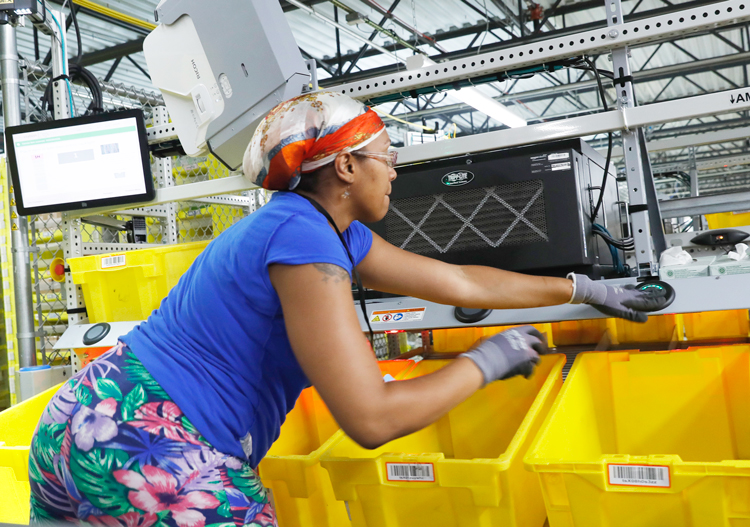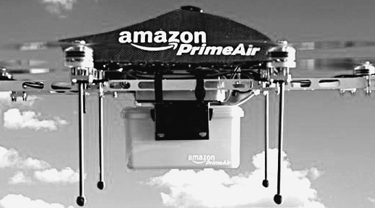Amazon, like its giant retail competitor Walmart, seeks to maximize its profits off workers’ backs. Both companies are stepping up use of robots to press their relentless speedup and intensify the exploitation of workers.
A study by the New York Committee for Occupational Safety and Health this year describes conditions at the Amazon Fulfillment Center on Staten Island in New York. Some 2,500 workers are employed there.
“The majority of workers (80%) were pressured to work harder or faster at their facility; 66% expressed experiencing physical pain while performing work duties, and 42% continued to experience pain even when they weren’t at work,” the report, titled “Time Off Task: Pressure, Pain and Productivity at Amazon,” says.
It points to similar oppressive conditions at other fulfillment centers, such as heat stress when workers were forced to work at an unsustainable pace at the Amazon warehouse in Lehigh Valley, Pennsylvania, in 2015.
Bosses are constantly spying on workers they falsely claim are their “associates.” In the Staten Island plant, “workers are evaluated based on the speed in which they work,” says the report, “and when workers take breaks, this time is considered ‘time off task.’” And if this ticks too high, you get fired.
Workers are finding ways to protest these conditions. Late in the evening on Oct. 2 some 60 Amazon warehouse workers in yellow vests walked out of a delivery center in Eagan, Minnesota, waving protest signs in a near-freezing rain. The workers — mostly women of Somali descent — demanded restrictions on the weight of the boxes, reversal of a 30-hour weekly workload cap and higher wages on night shift.
A few days earlier workers at an Amazon delivery center in Sacramento, California, organized to protest the firing of a worker who went an hour over on her bereavement leave after her mother-in-law died.
Driven by cutthroat competition, Amazon, Walmart, Target and other rivals are all pushing to squeeze more out of their workers. As employees organize to fight these worsening conditions, it lays the basis for uniting workers in stronger actions and building a union.
Amazon hired nearly 100,000 new workers in the third-quarter, most for jobs in the company’s warehouses and transportation division. Amazon now employs 750,000 workers worldwide — 400,000 of them in the U.S. And further hiring for Black Friday and Christmas is coming.
Meanwhile, Amazon’s profits took a nosedive over the same period, falling 26% from a year ago. This is the company’s first profit decline since 2017. Much of this results from extra expenses involved in Amazon’s drive to reduce shipping times for “prime” subscribers to just one day.
The company has put “heavy investment” into this, the Wall Street Journal notes, reorganizing its warehouses and looking to cut transportation costs, especially in cities and suburbs. But the biggest impact, which the capitalist media doesn’t say much about, is the bosses’ drive to force workers to pack, ship and deliver ever greater numbers of packages faster and faster, at the expense of safety and their health.
Amazon, and others in retail and transportation operations like Uber, Wing and UPS, are gearing up to begin drone deliveries directly to a customer’s doorsteps. Uber said it will run test drones in San Diego before the year ends. Amazon claims it is “testing” drone operations today and will begin delivering packages by drones “within months,” the Journal reported. Amazon says its drones will be deployed to make deliveries in 30 minutes or less, flying a maximum of 15 miles round trip. Earlier plans included use of blimps hovering over city neighborhoods releasing the drone fleet.
‘Smart’ device spying
“The prospect of being constantly surrounded by smart devices ready to listen in on your every conversation might fill many people with horror,” said the Financial Times Sept. 26. “But this is the future as imagined by Amazon — and it is arriving much faster than you might think.”
Since Amazon bosses introduced Alexa, they’ve been flooding the market with such gadgets, and Google is scurrying to catch up. A year ago Amazon announced new devices embedded with its Alexa voice-activated assistant to do things like turn on house lights or your microwave oven.
At the end of September Amazon began promoting an Alexa-embedded “ring that you tap to start a conversation, and AI [artificial intelligence] built into the frames of glasses,” the article said.
These devices are programmed to learn more and more about your habits and surroundings. All of this is then plugged into their profit-seeking algorithms, which churn out more and more ads to clutter up your “experiences” on your smart phone and computer.



